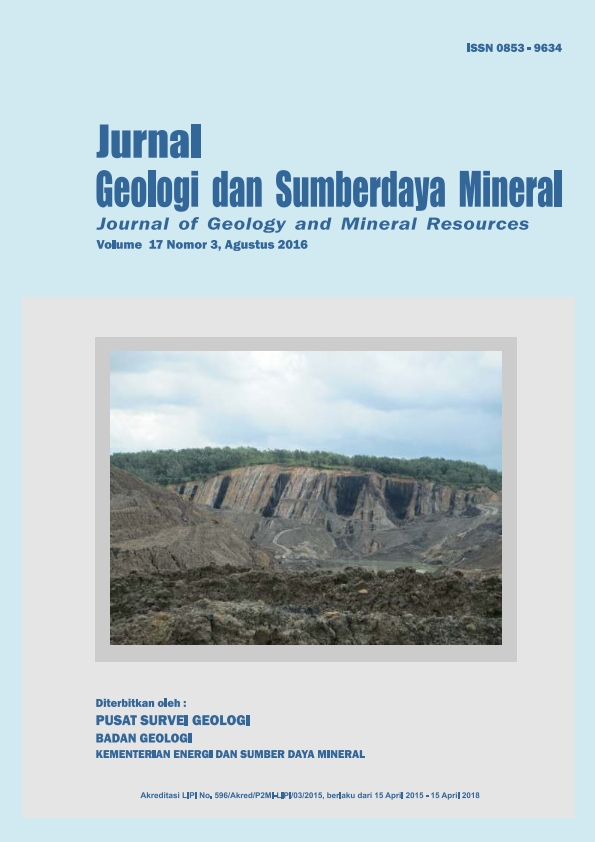INITIAL STUDIES OF THE MARINE GEOPHYSICAL SURVEY IN THE OFFSHORE WAIGEO, WEST PAPUA
DOI:
https://doi.org/10.33332/jgsm.geologi.v17i3.16Abstract
The offshore northern Waigeo situated and evolved within the obliquely converging of the Australian and Pacific plates boundary zone and  bound by an active left-lateral transform fault of the Sorong Fault Zone (SFZ) in the southern part. In general the Waigeo waters characterized by +200 nT to -150 nT of total magnetic intensities which indicate that the study area possibly overlain by a homogenous rock of oceanic origin in the form of highs (terranes) and lows (basins). Seismic data indicate that the morphology of the study area relatively steep due to the tectonic contact boundary between island-terranes of Waigeo and between Ayu islands and Pacific Oceanic crust. This tectonic contact boundaries characterized by the present of Waigeo Trough that extends southeast-northwest direction. Seismic data reveal about 1000 meters thick of acoustically chaotic to laminated, indicate fine-grained sediments of slumps at Waigeo Trough slope and trough floor, and about 1500 meters thick of pelagic sediments at the Ayu Trough.Downloads
References
Baldwin, S. L., Fitzgerald P. G. and Webb, L. E., 2012. Tectonics of the New Guinea Region. Annu. Rev. Earth Planet. Sci. 2012.40:495-520.
Charlton, T. R., Hall, R. and Partoyo, E., 1991. The geology and tectonic evolution of Waigeo Island, NE Indonesia, Journal of Southeast Asian Earth Sciences, Vol. 6, No. 3/4, pp. 289-297.
Darman, H. and Reemst, P., 2012. Seismic Expression of Geological Features in Seram Sea: Seram Trough, Misool-Onin Ridge and Sedimentary Basin. Berita Sedimentologi Number 23, March 2012, 28-61.
Fraser, T.H., 2015., A Hydrocarbon Exploration History of Papua, SEAPEX Exploration Conference Fairmont Hotel, Singapore.
Hall, R. and Spakman, W., 2015. Mantle structure and tectonic history of SE Asia, Tectonophysics, Vol. 658, Pages 14–45.
Harris, R.A, 2011. The nature of the Banda arc–continent collision in the Timor region arc-continent collision. Springer, Heidelberg, pp 163–211.
http://www.gebco.net/data_and_products/printable_maps/gebco_world_map/. 18 May 2016 01:33:09 GMT.
Kusnida, D., Naibaho T. and Firdaus, Y., 2016. Depositional Modification in Seram Trough, Eastern Indonesia. Jurnal Geologi dan Sumber Daya Mineral, Vol. 17, No. 2, Mei 2016, Hal. 25-31.
Laporan Pemetaan Geologi dan Geofisika Bersistem Lembar Peta 2815 dan 2816 Perairan Timur Waigeo, Papua Barat., 2015. Marine Geological Institute of Indonesia (unpublished).
Mc Caffrey, R., 2009. The Tectonic Framework of the Sumatran Subduction Zone. Earth and Environmental Sciences, Rensselaer Polytechnic Institute, Troy, New York 12180, Annu. Rev. Earth Planet. Sci. 2009. 37:345–66.
Pownall, J.M., Hall, R., and Watkinson, I.M., 2013. Extreme extension across Seram and Ambon, eastern Indonesia: evidence for Banda slab rollback: Solid Earth, 4, 277–314.
Riandini, P., Sapiie, B. and Nugraha, A.M.S, 2012. The Sorong Fault Zone Kinematics: Implication for Structural Evolution on Salawati Basin, Seram and Misool, West Papua, Indonesia. Berita Sedimentologi, No. 24, July 2012, 61-74.
Sapiie, B,. 2016. Kinematic Analysis of Fault-Slip Data in the Central Range of Papua, Indonesia. Indonesian Jour¬nal on Geoscience, 3 (1), p.1-16.
Downloads
Published
Issue
Section
License
Authors who publish articles in Jurnal Geologi dan Sumberdaya Mineral (JGSM.Geologi) agree to the following terms:
- Authors retain copyright of the article and grant the journal right of first publication with the work simultaneously licensed under a CC-BY-NC or The Creative Commons Attribution–ShareAlike License.
- Authors are able to enter into separate, additional contractual arrangements for the non-exclusive distribution of the journal's published version of the work (e.g., post it to an institutional repository or publish it in a book), with an acknowledgment of its initial publication in this journal.
- Authors are permitted and encouraged to post their work online (e.g., in institutional repositories or on their website) prior to and during the submission process, as it can lead to productive exchanges, as well as earlier and greater citation of published work (See The Effect of Open Access)










